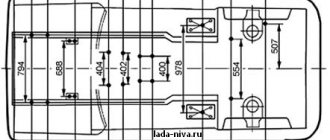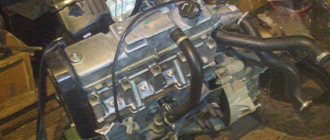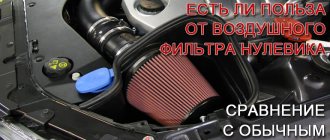Often my blog (and my channel) receives a lot of questions regarding the catalyst, and some readers still have many misconceptions in their heads. One of them (for example) is that if you remove this part of the muffler, then it will be VERY bad for the car, it will literally stand up and refuse to go! I decided to answer all the questions at once, so today we will talk: - is it worth removing it or not (what are the pros and cons of such manipulation), what will be the consumption after cutting it out, is it necessary to flash the ECU (and what are the risks), and well a few words about “deception”. In general, it will be interesting, as usual, the video version at the end...
At the very beginning, I would like to say that this unit is NOT SOMETHING IMPORTANT for the car, but now “a bunch of stones” will fly at me, they say, what are you saying, but what about ECOLOGY? But if we put aside all the exclamations of the “greens”, then a car without a catalyst will work BETTER, CONSUMPTION will be lower, and the POWER will increase a little.
What do spare parts manufacturers offer?
On the shelves of auto stores you can find all kinds of parts for tuning the exhaust system.
The production of mechanical simulators of the normal operation of the catalytic converter is made of bronze or chrome-plated steel. The price of such devices ranges from 400 to 800 rubles, and a standard installation at a service station will cost about 500 rubles. A spacer with a minicatalyst is offered much more expensive than its elementary counterpart, its cost is 1,500-4,000 rubles. Simple electronic emulators of industrial production are sold for 1,500-3,000 rubles. The range of prices for flashing ECU software is quite wide - from 1,000 to 30,000 rubles.
Hello, dear friends! I would like to study in more detail such an issue as replacing the catalyst with a flame arrester. Many people strive to carry out such a procedure, sometimes without understanding what it can lead to.
But I will try to be as objective as possible. I will tell you not only about the consequences, but also about what positive aspects arise when replacing the standard catalyst in the exhaust system of a car with a flame arrester or stronger. This is the same concept, but it is the flame arrester that is most widespread among car enthusiasts.
This is not to say that this is a universal element that can be installed always and everywhere. We need to understand this issue and get the most important answers.
Messages [1 to 25 of 29]
1 Topic by lrb79 12/04/2014 10:55:34
- lrb79
- Participant
- Inactive
- From: Krasnodar Center
- Registered: 18.12.2013
- Messages: 2138
Topic: Catalyst on the field 21214, is it necessary or not?
I couldn't find a topic similar to this one. The question is, how will the car change, and will it change at all, if you remove this bullshit?
2 Reply from Vist 12/04/2014 11:10:50
- Vist
- Participant
- Inactive
- From: Art. Novotitarovskaya
- Registered: 25.01.2011
- Messages: 4778
- User Karma: 1
Re: Catalyst on the field 21214, is it necessary or not?
lrb79 , she will go.
3 Reply from lrb79 12/04/2014 11:15:40
- lrb79
- Participant
- Inactive
- From: Krasnodar Center
- Registered: 18.12.2013
- Messages: 2138
Re: Catalyst on the field 21214, is it necessary or not?
I also heard that it’s easier for a car to work without it, there are probably people who removed it, I’d like to hear reviews about the consequences
4 Reply from igor4737 12/04/2014 11:47:27
- igor4737
- Participant
- Inactive
- From: Krasnodar
- Registered: 29.08.2007
- Messages: 19785
- User Karma: 13
Re: Catalyst on the field 21214, is it necessary or not?
A simple cut will not solve the problem; it requires a snag and firmware. The dynamics will become better, especially if the catt is clogged, the “euro” parameter will decrease.
5 Reply from Savage 12/04/2014 11:49:30
- Savage
- Participant
- Inactive
- From: Krasnodar, FMR
- Registered: 07.05.2008
- Messages: 8552
- User Karma: 7
Re: Catalyst on the field 21214, is it necessary or not?
And then solder your brains to reflash it to Euro-2. Nah, lazy. It's better to buy a new catalyst.
6 Reply from MALIK 12/04/2014 12:15:50
- MALIK
- Participant
- Inactive
- From: Stavropol
- Registered: 13.01.2013
- Messages: 168
Re: Catalyst on the field 21214, is it necessary or not?
Depending on what year the Nyvka is, you may not need to change it.
7 Reply from Goshan 12/04/2014 12:25:01
- Goshan
- Participant
- Inactive
- From: Hero City
- Registered: 14.01.2011
- Messages: 1318
Re: Catalyst on the field 21214, is it necessary or not?
I have a 2003, I threw out the cat, inserted a pipe (sold in the store), didn’t flash anything, subjectively the traction at the bottom has become better
8 Reply from igor4737 12/04/2014 12:33:54
- igor4737
- Participant
- Inactive
- From: Krasnodar
- Registered: 29.08.2007
- Messages: 19785
- User Karma: 13
Re: Catalyst on the field 21214, is it necessary or not?
If the second lambda probe is worth it, then you can flash it anyway.
9 Reply from lrb79 12/04/2014 12:51:00
- lrb79
- Participant
- Inactive
- From: Krasnodar Center
- Registered: 18.12.2013
- Messages: 2138
Re: Catalyst on the field 21214, is it necessary or not?
The car is from 2003, there is no sensor after the catalyst. I think after 11 years this catalyst has already died a long time ago..
10 Reply from umrnet 12/04/2014 12:54:14
- umrnet
- Participant
- Inactive
- From: Krasnodar YMR
- Registered: 11.06.2010
- Messages: 5828
Re: Catalyst on the field 21214, is it necessary or not?
I immediately knocked out, flashed and turned off 2 lambdas. It was Euro-4, it became Euro-2. Maybe the firmware is not ice, I didn’t notice much when I arrived, the car is 2012. Before that I used to beat it on Goetz, it was more fun there.
Edited by umrnet (04.12.2014 12:54:54)
11 Reply from Serval 12/04/2014 13:33:55
- Serval
- Participant
- Inactive
- From: Rostov-on-Don
- Registered: 29.10.2007
- Messages: 630
Re: Catalyst on the field 21214, is it necessary or not?
About three years ago I tore the plug on a Patrick Euro 3, at the same time knocked out the catalyst, before that I smoked the Internet - the second lambda probe does not affect the brain, it only lights up an error - the catalyst is faulty, at the same time I unscrewed the lambda and replaced it with a plug from the oil sump, the error was due to gas it burns for anyone (if you don’t match the gas-gasoline parameters, which no one really knows how to do, and you’re lazy to figure it out on your own) I periodically check for other errors on the computer. The procedure does not affect the power, it does not affect the consumption either, it does affect the pickup. The catalyst was knocked out with a hammer drill with a long drill, everything is quite simple. Here's my experience with this
Edited by Serval (04.12.2014 13:34:59)
Three in one - or how to protect the catalyst
Replacing a failed catalyst will not be cheap, so it would be good to know in advance what problems there are with it, and how things stand with them on the spare parts market.
Until recently, we only knew the following about the catalyst: it is a thing that is not clear why it is needed, it is not clear how it works, that our gasoline “kills” it, in general - nothing but troubles. Cut - and no problem! But gradually we began to get used to the fact that the catalyst is still a useful thing, at least the thoughts of “surgical intervention” in the exhaust system are visited less and less often by fewer and fewer people.
In the spring, when traffic police officers begin the “fight for clean air,” another problem falls on us - we need to regulate the CO. Owners of cars equipped with catalysts don’t even think about it, and they pass CO checkpoints without trembling knees or fear for their wallet. True, the same wallet can “lose a lot of weight” for another reason.
How do they work?
When the working mixture is burned, a number of combustion products harmful to human health are formed, in particular, carbon monoxide (CO), various hydrocarbons (CH) and nitrogen oxides (NO). Although these substances make up only 1% of the total exhaust (the rest is nitrogen, carbon dioxide and water vapor), they are very harmful and require neutralization.
As DKstyle.ru experts say, a catalytic converter is a simple device in which a complex chemical process occurs. “Inside the stainless steel case there is a ceramic or metal “brick” that has a honeycomb structure. This monolith has a huge surface area, and all of it is covered with a thin layer of a special alloy - the catalyst itself, containing platinum, rhodium and palladium. It is these precious metals that are responsible for the wonderful properties of the catalyst, and they also determine its high cost.”
Exhaust gases “wash” the surface of the monolith, and when the temperature reaches a “critical” value of 270° C, the catalytic reaction begins. Carbon monoxide is converted to dioxide (carbon dioxide), hydrocarbons are converted to water and again carbon dioxide, and oxides of nitrogen are converted to water and nitrogen. All this is less harmful to the environment.
Also interesting: Everything you need to know about differential locks on Niva
Catalytic converters can quite effectively reduce exhaust toxicity, while they do not affect fuel consumption and engine power. In the presence of a catalyst, the exhaust back pressure slightly increases, causing the engine to lose 2-3 hp, but this is practically the entire “payment” for cleaning the exhaust.
Why do you need a catalyst?
I already have an article - what is it , I won’t repeat it. You need to understand that a catalyst (and scientifically, a catalytic converter) is needed only to clean the car's exhaust from harmful emissions and make them less harmful.
In simple words, it purifies harmful gases (while glowing almost “red hot”) and “almost” harmless CO2 and N2, O2 emerge from harmful CO, CH and other compounds. This way we save the environment at least a little.
Its structure is quite simple - it is a thickened pipe, which inside has something like a honeycomb, only long and hollow. They are usually made of ceramic elements coated with noble metals (usually platinum group metals are used - iridium, rhodium, palladium).
It is because of this that it costs, to put it mildly, quite a bit, from 30 to 150,000 rubles, it all depends on the class of the car and its volume.
In order for gases to transform from toxic to less harmful, the temperature of the catalyst must be about 750 degrees Celsius, otherwise the chemical reaction will not occur. The gases that come out of a car engine have a temperature of approximately 500 - 550 degrees Celsius (which is not enough), when they pass through the catalyst, a chemical reaction occurs with the release of heat, thus heating just the right amount (750 - 900 degrees).
Why do they replace?
I won’t tell anyone a secret if I say that the decision to replace the catalyst with a flame arrester is largely due to the economic component. That is, the car owner simply wants to save money.
Just look at the cost of this element. If we take into account even domestic cars, the price tag will look impressive. Now imagine that your VAZ has already covered about 200-300 thousand kilometers. And here the need arises to change the catalyst. Such a purchase will cost 50-70 thousand rubles.
If you decide to install such a design for yourself, do not forget about the mandatory equipment of a stronger with blende. Decoy, catalyst emulator, lambda decoy. Call it what you want. This will not change the essence.
The lambda decoy serves to correct the incoming signal from the oxygen sensor to the electronic control unit of your car. Moreover, it is necessary to install such a device if a flame arrester is installed in place of the catalyst.
Without doing this, the ECU will begin to perceive the operation of the exhaust system as problematic, and the emergency mode of operation of the internal combustion engine will begin to constantly turn on. This will result in a decrease in engine life and an increase in fuel consumption.
Similar designs, made from stronger and blende, can be installed on any car:
- Mazda 3;
- Hyundai Elantra;
- Chevrolet Lacetti;
- Ford Focus;
- Renault Megane;
- Toyota Prado 120;
- Hyundai Solaris;
- Opel Astra;
- Niva Chevrolet;
- Kia Rio, etc.
The use of deception should not be ignored. You already know about the consequences of such a rash decision.
How to properly remove a catalyst on a Chevrolet Niva
Qualified specialists professionally handle the removal of catalysts on Chevrolet Niva cars. To quickly resume normal operation of the exhaust system, order services from our technical center. Our technicians will carefully cut out the catalytic converter using the necessary equipment and tools. Compliance with established instructions is the main rule of our specialists’ work.
Cutting out a faulty exhaust system device is carried out sequentially. Specialists competently perform the work:
- dismantle the catalyst, taking into account the characteristics of the machine;
- remove ceramics;
- install flame arresters if the upper catalyst is cut out;
- install a lambda probe blende;
- They reprogram the car's electronic system.
Malfunction of the catalyst: characteristic signs
On a Chevrolet Niva, the average service life of the catalyst is about 70 thousand kilometers. However, the need for replacement may come sooner. This is influenced by operational factors.
Signs of catalytic converter degradation:
- Check engine indicator. The ECU will indicate a malfunction because the sensor in the catalyst will indicate incorrect data. The indicator will light up instantly.
- Reduced motor power. Failure of the catalyst leads to difficulty in removing exhaust gases. It is difficult for inexperienced drivers to feel this moment. It is clearly visible only at high speeds on the highway when overtaking or in advanced cases, when there is little left of the cells.
- Increased fuel consumption. The lambda probe provides the ECU with incorrect data, which causes a lean mixture to be supplied to the engine. The reduction in power forces the driver to press the gas pedal harder. This leads to an increase in fuel consumption - by 10-15% on average.
- Problems starting the engine. Clogging of the catalyst honeycomb makes it difficult for exhaust gases to flow out. The cylinders are not completely cleaned. Starting becomes difficult.
Experienced mechanics will give an accurate assessment of the problem. Malfunctions in the car engine are a reason to contact a service center.
Preliminary nuances
Let's start with the simple concept of a catalyst, which for some reason they want to replace with their own hands or the hands of a craftsman with a flame arrester. The catalyst is a device that is part of the exhaust system. It serves to purify gases produced during fuel combustion from all kinds of impurities.
But if this device breaks down or becomes dirty, returning it to its original level of performance is not so easy. In fact, car owners make one of 2 decisions. In the first case, they buy a new part and install it in place of the old one. The second option is to replace the catalyst with a device called a flame arrester.
Also interesting: Niva tire rating 2121
Car enthusiasts are divided into 2 camps. Some argue that installing a stronger is an excellent tuning solution. Others are confident that such modernization will only cause harm.
But how dangerous would it actually be to remove the catalyst? And if this is harmful, then why do service stations actively offer this service in Yekaterinburg, St. Petersburg, cities such as Moscow, Voronezh, Volgograd and other parts of the country? And the price isn't that bad.
It's all about the myths that have formed around flame arresters. They look like this:
- the motor begins to quickly fail;
- the muffler breaks down;
- the engine is very noisy;
- exhaust gases become more dangerous in their composition;
- great harm is caused to nature;
- in the cabin you can be poisoned by the exhaust;
- the engine consumes fuel in huge quantities;
- motor life is reduced significantly;
- the exhaust system lasts quite a bit, etc.
But it was not in vain that I focused on the fact that these are myths. Most of them are very far from the truth.
Therefore, now we need to study all the pros and cons, consider the essence and concept of a flame arrester, and come to the appropriate conclusions.
Pros and cons of deletion
I have prepared a small sign with the pros and cons of what will happen if you remove the catalyst
| MINUSES | PROS |
| Increase in harmful substances in the exhaust, decrease in the environmental component | There is no need to buy a new catalyst, because it is very expensive |
| The smell of the exhaust becomes much more toxic, sometimes this exhaust penetrates into the car (it smells unpleasant) | A small increase in power (really small in terms of error, about 3%) |
| Exhaust sound. After knocking out the catalyst honeycomb, it is advisable to install a flame arrester, otherwise there will be a ringing sound from the empty “can” (especially at high speeds) | You can install a 4-2-1 or 4-1 spider , plus more power (which is said out of the blue) |
| You need to install either a fake or new firmware for EURO2 | Reduced fuel consumption (also about 3%) |
| Increasing the life of the power unit, because ceramic dust can get into the combustion chambers and wear it out prematurely |
Adviсe
Whatever method is used, it is important to know that after removing the catalyst, the electronic unit will still show an error. This is accompanied by a yellow "Check Engine" light. And all because the oxygen sensor will record incorrect data about the amount of oxygen remaining in the catalyst. How to solve this issue?
Another method is flashing the electronic unit. However, it is better to do this operation at a service station. The essence of the process is to install software for Euro-2. Thus, the ECU will not have information about the catalyst, and the engine will operate normally without additional interference. This method is relevant if the catalyst is removed at a service station. After all, in the service, the installation of a flame arrester is carried out in conjunction with the firmware of the electronic unit.
Also note that the length of the common exhaust system pipe does not change. Therefore, you should not install a new rear bumper on the Chevrolet Niva (whether it is restyling or pre-restyling, it does not matter). The system will operate normally. The only thing that will change for the worse is the smell of gas.
Chevrolet Niva 2012, engine Gasoline 1.7 liter., 92 hp, AWD drive, Manual — tuning
Comments 81
Does anyone have a part number for the flame arrester?
they did it for me without removing the muffler) they screwed you up here of course(
the main thing is that it works)
as if they added 2 horses to the trough)
Captain-Smollett
Today I replaced the original resonator with a regular plug for 1200. The effect felt zero. I flashed it myself on Paulus (I don’t remember the firmware identifier). My dear one went broke, it’s a pity to buy for 8-10 thousand. Now the sound is like a gazelle (
This seam is definitely fucked up! no way to be more equal?
That is, it turns out that I need the firmware for about 5 thousand together with the service of a person and about another 2 thousand to remove the catalyst and weld the plug, it’s still cheaper than changing the catalyst more than once.
You can flash it cheaper or do it yourself for free
Do you remember the size of the strongman?
And don’t forget to flash it under Euro-2 without adjusting the lambda, of course, if you haven’t done it before...
What kind of stupidity is it to remove the catalyst? On the contrary it is necessary to put
It’s stupid to drive with it and choke your engine, when next to you a KamAZ truck with one press of the gas pedal will shoot into the atmosphere as much shit as a Niva for 2 euros without cata in a month)))
What kind of stupidity is it to remove the catalyst? On the contrary it is necessary to put
Hmmm. Guys are hands-on. Such things are grabbed in place to prevent curvature and further application of sealant and bending. The joints are jamb because they didn’t clean the metal for welding, they don’t give a damn about the shells. The tail of the resnator can be seen close to the heat shield, it will knock. In general, take them off and go beat them with this pipe. And when you change the oil seals, everyone cries
I don’t even want to remember about this pipe... RK has been crying for 4 years now, such a sad fate it has, the main thing is that the oil level does not go below the minimum
Replacement methods
So, what to do if a catalytic converter malfunction has been diagnosed? You can try to replace the filter element with a new one. This will be correct from an environmental point of view. But from a budget point of view, replacement will entail significant expenses. After all, a new catalyst on a Chevrolet Niva costs from 15 thousand rubles, and it is not a fact that it will last 70 thousand kilometers. Thus, owners resort to different alternatives. This:
- Removing the Chevrolet Niva catalyst and then installing a flame arrester.
- Knocking out the ceramic filler of the old neutralizer.
We will look at the features of each method below in the article.
Ways to solve problems
One of the reasons that the car’s performance has decreased may be due to mechanical damage to the CAT. Since this device is covered with ceramics inside, and if the exhaust pipe hits any surface strongly, this ceramics can fly apart, which will lead to a characteristic noise, in which case it will not be possible to repair it, in this case there are several options:
- Buy a new catalyst module
- Knock out the CAT present in it
- Replace a clogged catalyst with a flame arrester (stronger)
Each method has both its advantages and disadvantages. Buying a new one is costly; getting rid of the catalytic module and replacing its metal insert can lead to the operation of the muffling system being disrupted, since hot exhaust will begin to enter there, and a characteristic sound will appear when driving; the advantage of this method is its low cost. Many people resort to replacing it with a flame arrester because it is not expensive, and the bonus will be an increase in engine response.
Also interesting: VAZ 21214 Niva injector fuse box diagram "
To summarize, we can conclude about the pros and cons of removing this element. The advantages include the fact that fuel consumption will decrease due to the fact that some recycled particles will no longer be recycled and will go back into consumption. And the main disadvantages include:
- An error will appear on the dashboard
- A characteristic noise will appear
- A car without it will be classified as an emergency vehicle.
- The unpleasant odor will intensify, which, in addition to polluting the environment, will seep into the cabin.
Therefore, whether to leave, replace, or completely remove the catalyst, whether it will be done independently or by specialists, will, of course, be decided by the car owner himself.
When the catalytic converter fails, the engine can no longer operate normally. The electronic panel displays errors that indicate a malfunction of the exhaust system. Only experienced technicians can quickly solve catalytic converter problems.
Our company has been servicing cars for many years. We guarantee a professional approach to solving any problems with machines. If you need to remove the catalyst, use the services of our specialists. They will do the job efficiently, while the cost of maintenance will be low. The technical center provides services daily. You can place an order for catalytic converter cutting not only on weekdays, but also on weekends.
Advantages and disadvantages of removal
Before talking about its disadvantages and advantages, you should first of all pay attention to the conditions under which it is used. Because if, for example, the ignition is faulty or the fuel is of insufficient quality, then all this, if not applied, affects its operation and leads to failure. Therefore, if the car has problems with dynamics, or gasoline consumption has increased, the first thing you should pay attention to is the condition of the exhaust system. The normal operation of the element, or as it is called CAT, is designed for 50-150 thousand kilometers, and its service life directly depends on the conditions under which it is operated.
Therefore, before resorting to a complete replacement of a part, pay attention to how the ignition system is adjusted, what fuel is used, this all directly affects its operation. It is also important to use high-quality oils; this is also an important aspect related to how long the catalyst will last.
As for repair work, this procedure is not complicated, you can do it yourself, without the help of specialists, this will help you save money, since a new part is not cheap, and if you entrust this work to a specialist, it will be quite expensive. Of course, if you do not have free time and you do not have problems with money, then you can resort to the help of a specialist.
Removing the catalyst on the field 21214: consequences
Once removed, you will notice a significant increase in power. But let us immediately note that it will be within the factory values. After all, before this, the engine simply suffocated on its own gases and the power could drop by almost half. Gases will freely leave the combustion chamber - the risk of valve burnout is minimal.
Fuel consumption after removing the catalyst is within the factory values. But malfunctions will occur very rarely. After all, “when cold” the ECU is guided by average lambda values. And so on until the catalyst warms up. After removing it and flashing it, the unit will think that the neutralizer is already warmed up and will immediately begin to prepare the correct mixture.
The car will become less demanding on the quality of the fuel used. Even if there are deposits, all the dirt will fly straight into the pipe without being trapped in the filter honeycombs.
As for the negative aspects, after such “tuning” your environmental standards will immediately drop to Euro-2. But in Russia there are no penalties for this. It is completely legal to drive a Chevrolet Niva without a catalyst.
The catalytic converter is knocked out, is this bad for the car?
As I wrote above, this is simply an environmental system, and if it is not there, then the car, on the contrary, will improve its characteristics (power, consumption). To put it simply, the engine doesn’t care about this converter, whether it is there or not.
But why on many cars, if this unit fails (say, melted, clogged or crumbled), the CHECK ENGINE and the car begins to behave abnormally, traction disappears, sometimes it trots a little, and simply may not start at all.
And here, friends, everything is simple. If the catalyst is melted or clogged, then the exhaust gases cannot pass through it normally, which means that some returns back into the combustion chamber and makes the newly introduced combustible mixture less efficient. The motor is choking itself.
If there is no melting, but the “CHECK” light comes on, then perhaps it has simply worn out due to high mileage. In modern cars there are so-called oxygen sensors (lambda umbrellas), one is located in front of the catalyst, the other after and detects the presence of harmful compounds; if their percentage has increased, then the second (or also called the lower “lambda”) gives a signal that the converter is not working ( or it doesn’t do its job as it should) AND IT NEEDS TO BE REPLACED. By the way, some cars may not even start (a tribute to the environment).
Thus, by knocking out or removing it, you simply free the car’s exhaust tract from the obstacle in the form of a filter and lower its environmental standards. BUT AGAIN - THIS DOES NOT AFFECT THE RESOURCE OF THE POWER UNIT !
BUT in order for your car to drive normally, you need to upgrade to a lower environmental class (usually EURO2) or install a fake one. Otherwise, the program in the ECU will not allow you to drive normally.
Removing a Chevrolet Niva catalyst: preliminary diagnostics
To accurately verify the malfunction, you will need computer diagnostics of the engine.
At the service station this procedure is performed as follows. The wizard connects to the OBD-2 connector and scans for errors using a laptop. On a Chevrolet Niva they will have the following code:
All these errors indicate “ineffective operation of the neutralization system and the lambda probe heater.”
After diagnosis, the specialist makes a decision. This could be replacing the lambda probe (this also happens with a working catalyst, at a mileage of up to 40 thousand), or completely removing the catalytic filter.
If we consider indirect symptoms, it could be:
- toxic odor of exhaust gases;
- metallic rattling and ringing in the muffler.
In the latter case, the ceramic part of the catalyst may peel off. It cannot freely leave the system and causes a characteristic rumble.
Read news about the new Niva
- Is it worth buying a Honda Ridgeline I for a million rubles - KOLESA.ru - automobile magazine
- Do-it-yourself Niva tuning is accessible even to a beginner
- What are low pressure tires for and what are their advantages?
- Tire rotation
- Choosing the best used crossover. Rating of used SUVs. TOP 10
- Contacts: Shop NIVA Lada 4×4 – Shop auto parts and accessories for Niva and NIVA-Chevrolet cars
- Luaz or Niva
- Checking control devices and their sensors Niva 2121, Niva 2131











